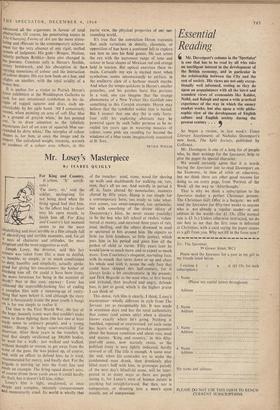The Painter-Critic
Opponents of Mr. Patrick Heron, the most in- telligent of our painter-critics, have accused him in the past of just that fallacy. They have sug- gested that as a critic he has exaggerated the significance of those abstract painters with whose kind of problems he was himself wrestling in his studio. That is untrue, however. There have been occasions, while Heron's own compositions were referring to nature, when he has reasonably advanced all the arguments in favour of total abstraction. Of course, his penetrating essays in The Changing Forms of Art are the more stimu- lating and relevant to the contemporary achieve- ment for the very absence of any rigid, unified system of judgment. His gods—Braque, Matisse, latterly perhaps Rothko—have also changed in his journey. Constant only is Heron's flexible, , wristy brushwork, and his absorption in the• varying sensations of colour and the interaction of colour shapes. His eye now feeds on a hue, and alights on another, with the total avidity of a honey-bee.
It is useless for a visitor to Patrick Heron's latest exhibition at the Waddington Galleries to look for any intentional symbolism in his de- signs of ragged squares and discs, each un- mistakably by his agile hand. 'All I consciously intend, when painting an area of soft lilac blue in a ground of greyish white,' he has pointed out, 'is to draw attention to the infinitely mysterious fact of an area of squarish blue sur- rounded by dirty white.' The interplay of colour shapes is, for him, at once the image and its import. The calculated weight, intensity, warmth I. 0r coolness of a colour area reflects, in this
purist view, the physical properties of our sur- rounding world.
Its true that the conviction Heron transmits that such variations in density, closeness, or opposition of hue have a continent left to explore can lure us into his field games. He can arrest the eye with the narrowest range of tone and colour in basic shapes of Mexican red and orange held in tension. But optical exercises these re- main. Certainly my eye is excited most when symbolism seems unconsciously to surface, in the mulberry claw of a harbour mouth maybe. And when the tempo quickens in Heron's smaller gouaches, and his patches burst like portents in a void, one can imagine that the strange phenomena of a New Yorker like Gottlieb owe something to this Cornish example, Heron may believe that the symbolist within him is buried. But I suspect that one day (he is only forty- four still) his exploring . abstracts may be powered again by such fuller purpose as he re- vealed ten years ago in wavering mosaics of colour, some pink sea receding far beyond the windows of a blue room imaginatively conceived at St. Ives.
Ni VILE WALLIS



































 Previous page
Previous page